Ionic Liquids and Their Applications in Sample Preparation
LCGC North America
Ionic liquids have tunable selectivity for specific classes of analytes, giving them distinct advantages over organic solvents.
This short review covers the use of ionic liquids (ILs) and polymeric ionic liquids (PILs) in solid-phase microextraction (SPME) and dispersive liquid–liquid microextraction (DLLME).
Over the past decade, ionic liquids (ILs) and polymeric ionic liquids (PILs) have been widely studied and applied in multiple areas of science and engineering. ILs are organic salts with melting points at or below 100 °C, and PILs are polymers synthesized from IL monomers. These "molten salts" are typically composed of an organic cation and an organic or inorganic anion. Given that the cations and anions can be readily interchangeable to form new compounds with different properties, it has been estimated that there can be as many as 1018possible combinations of ILs (1). ILs and PILs have been previously applied in various extraction methods including single-drop microextraction (SDME), liquid-phase microextraction (LPME), solid-phase microextraction (SPME), dispersive liquid–liquid microextraction (DLLME), hollow fiber–supported liquid membrane extraction (HFSLME), and solid-phase extraction (SPE) (2–7). With the exception of sorbent-based extraction procedures, many of these sample preparation methods involve the use of organic solvents. Compared to traditional organic solvents, ILs can be engineered to exhibit low to negligible volatility, and sometimes lower toxicity, which makes their use in sample preparation highly attractive (3).
Although ILs and PILs have been applied in many sample preparation methodologies, this article will focus on the application of these compounds in two rapidly emerging techniques, namely, SPME and DLLME. ILs and PILs exhibit a number of unique properties that make them highly useful extraction media in SPME and DLLME because of their high thermal stability, variable viscosity, and negligible vapor pressure. However, the main advantage of using ILs and PILs is their tunable selectivity for specific classes of analytes. By imparting functional groups to the chemical makeup of ILs and PILs, the selectivity of these compounds can be enhanced as a result of favorable analyte-to-IL or -PIL interactions. As a result, higher analyte enrichment factors and extraction efficiencies often can be achieved. In this column installment, the thermal stability, viscosity, and selectivity of ILs and PILs and their relevance to SPME and DLLME will be discussed. An overview of the basic principles of operation for both DLLME and SPME will be covered. Additionally, the current challenges of ILs and PILs in sample preparation will be highlighted and ideas for future research will be discussed.
Unique Characteristics of Ionic Liquids and Polymeric Ionic Liquids for Applications in DLLME and SPME
Thermal Stability
The thermal stability of an IL or PIL is critical for applications in sample preparation that require the use of high temperatures. When SPME is coupled to gas chromatography (SPME-GC), the IL- or PIL-based sorbent materials must be capable of withstanding the high operating temperatures of the GC injector (250–280 °C) during analyte desorption (5). Figure 1 shows the structures and names of common ILs and PILs used in DLLME and SPME. Most ILs or PILs used in SPME and DLLME are composed of imidazolium-, pyrrolidinium-, or phosphonium-based cations. Functionalizing the nitrogen atoms of the imidazolium ring with linear aliphatic hydrocarbons can further increase the thermal stability of the resulting IL (8). The anion, however, often plays a more significant role in the thermal stability of ILs and PILs (9). Typically, smaller and less polarizable anions, such as halides, decrease the overall thermal stability because of their susceptibility to undergoing nucleophilic substitution with the alkyl substituents of the IL cation (10). On the other hand, larger anions that exhibit higher electron delocalization, such as bis[(trifluoromethyl)sulfonyl] imide ([NTf2]-) or triflate ([TfO]-), produce compounds with higher thermal stability (8,10,11).
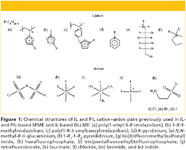
Figure 1
Viscosity
Similar to the thermal stability, the viscosity of an IL or PIL is an important consideration in sample preparation, particularly for SPME and DLLME. The viscosity of ILs is governed largely by their intermolecular interactions, such as hydrogen bonding, van der Waals forces, and electrostatic interactions (12). ILs containing halide anions typically exhibit higher viscosities because of their ability to undergo stronger hydrogen bonding and electrostatic interactions with the cations while larger or more asymmetrical anions often possess lower viscosities (11,13,14). Substituting the cationic moiety of the IL with linear or branched aliphatic hydrocarbons will also increase the viscosity as a result of enhanced van der Waals interactions (9,12,14,15). In SPME, it is favorable to use ILs and PILs with relatively high viscosities because the viscosity of ILs tend to decrease at high temperature, such as during thermal desorption in the GC injector at high temperatures. Such thermal desorption may result in the IL coating flowing off the fiber support into the GC injector and jeopardizing both the fiber lifetime and its analytical performance. In addition to producing chromatographic ghost peaks, active sites, and chromatographic background noise, IL buildup within the injector may require frequent GC system maintenance. In IL-based DLLME, the viscosity of an IL extraction solvent can be modified to a certain extent by using a disperser solvent, an organic modifier that is miscible in both the sample matrix and the extraction phase. In cases where a disperser solvent is not used, it is necessary to use an IL with a suitable viscosity to allow for homogenous mixing during extraction.
Variable Selectivity by Structural Tunability
A major advantage to using ILs and PILs as extraction phases in sample preparation is their tunable selectivity for specific analytes. For example, it is beneficial to take advantage of the electrostatic interaction capabilities of ILs in addition to functionalizing them with hydrogen-bond acidic hydroxyl groups to enhance the extraction efficiency of deoxyribonucleic acid (DNA) in DLLME (16). Likewise, the extraction efficiency of analytes containing aromatic moieties, such as polycyclic aromatic hydrocarbons (PAHs), can be enhanced by imparting aromatic character to the PIL-based sorbent coating to increase p-p interactions in SPME. In the same context, engineering PILs with large aliphatic hydrocarbon chains can increase the selectivity of long-chained alkyl halides as a result of enhanced dispersion interactions (17). Therefore, to fully exploit ILs and PILs as selective extraction media, the intermolecular interactions between these compounds and the target analytes should be carefully considered.
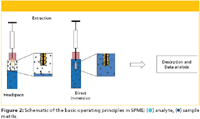
Figure 2
ILs and PIL-Based Sorbent Coatings in Solid-Phase Microextraction
SPME, developed by Pawliszyn and coworkers in the early 1990s, is a popular sorbent extraction technique that combines sampling and sample preparation into one step. Unlike other sorbent-based extraction techniques such as SPE, SPME non-exhaustively preconcentrates the analytes of interest (18,19). Figure 2 illustrates the basic operating principles of SPME. Initially, a fiber support is coated with a thin film of a sorbent coating. During the extraction step, the coating is exposed to a sample solution containing the analytes of interest, either in headspace or direct-immersion mode. Extraction is achieved via adsorption, partitioning of the analytes to the sorbent coating, or both adsorption and partitioning. The analytes are then desorbed from the sorbent coating by exposing the fiber to a GC injector at high temperatures for thermal desorption or to a high performance liquid chromatography (HPLC) injector for solvent desorption (20).
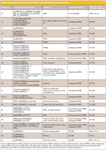
Table I: Summary of studies for IL- and PIL-based SPME and IL-based DLLME
The use of ILs as sorbent coatings for headspace SPME was first investigated by Liu and coworkers in 2005 (21). Table I provides a brief summary of all studies discussed in this article. The 1-octyl-3-methylimidazolium hexafluorophosphate ([C8MIM][PF6]) IL was exploited in the extraction of benzene, toluene, ethylbenzene, and xylenes (BTEX) in paints. The IL-based coatings provided lower limits of detection (LODs) for the BTEX analytes compared to a commercial poly(dimethylsiloxane) (PDMS) coating, demonstrating its high selectivity. Nevertheless, the IL-coated fiber was not reusable and had to be recoated following every extraction or desorption step as a result of a decrease in the viscosity of the IL and it flowing off from the fiber (21). Following this initial study, different approaches were reported to increase the amount of IL loaded on the fiber as well as to stabilize it on the fiber. A perspective of the different sorbent coating techniques used in IL- and PIL-based SPME is shown in Table II. A Nafion (DuPont) membrane was applied to pretreat the fiber surface before loading various ILs possessing the [TfO]- anion on a bare silica fiber (22). This method not only allowed for an even IL coating but also enabled a large volume of these ILs to be stabilized on the fiber via electrostatic interaction with the Nafion membrane (22). A wet-chemical etching method using ammonium hydrogen difluoride was developed by Huang and coworkers to increase the surface area of a bare fused silica before IL loading (23). A larger volume of the 1-butyl-3-methylimidazolium hexafluorophosphate ([C4MIM][PF6]) IL was loaded using the etched fiber compared to a non-etched bare fiber for the extraction PAHs in which a fivefold increase in extraction efficiency was observed (23). Amini and coworkers chemically bonded an organosilane-derivatized IL, namely, 1-methyl-3-(3-trimethoxysilyl propyl) imidazolium bis[(trifluoromethyl)sulfonyl]imide ([MTPIM][NTf2]), to a bare silica fiber. The chemically immobilized coating provided improved mechanical and thermal stability in addition to being reusable up to 16 extraction or desorption steps (24).

Table I (continued): Summary of studies for IL/PIL-based SPME and IL-based DLLME
In an effort to further extend the lifetime and reusability of the sorbent coating, our group exploited PILs as selective SPME sorbent coatings (25). Compared to ILs, PILs possess higher thermal stability and are less prone to flowing when subjected to high desorption temperatures. Three PILs, namely, poly(1-vinyl-3-hexylimidazolium bis[(trifluoromethyl)sulfonyl]imide) (poly([ViC6IM][NTf2])), poly(1-vinyl-3-dodecylimidazolium bis[(trifluoromethyl)sulfonyl]imide) (poly([ViC12IM][NTf2])) and poly(1-vinyl-3-hexadecylimidazolium bis[(trifluoromethyl)sulfonyl]imide) (poly([ViC16IM][NTf2])), were applied as PIL-based coatings for the selective extraction of fatty acid methyl esters (FAMEs). Outstanding fiber lifetimes of approximately 150 extractions were observed when using these PIL-coated fibers (25). Subsequent investigations focused on improving the coating-to-analyte selectivity by imparting various substituents to the PIL backbone. For example, aromatic moieties were imparted to the poly((1-4-vinylbenzyl)-3-hexadecylimidazolium bis[(trifluoromethyl)sulfonyl]imide) (poly([VBC16IM][NTf2])) PIL to produce enhanced selectivity toward PAHs by p-p interactions, illustrated in Figure 3 (17,26,27). As shown, the non-functionalized poly([ViC16IM][NTf2]) PIL resulted in a significant increase in the mass of PAHs extracted compared to a commercial PDMS coating. Exploiting the benzyl-functionalized poly([VBC16IM][NTf2]) PIL provided even higher extraction efficiencies, especially for benzo[a]anthracene and chrysene (26). The selectivity of hydrogen-bond acidic analytes, such volatile fatty acids (VFAs), alcohols, aldehydes, and amines was significantly improved by incorporating a hydrogen-bond basic chloride anion to the PIL-based sorbent coating (17,28–31). Favorable selectivity was obtained in the extraction of long-chained aliphatic alkyl halides by using a glucaminium-based PIL comprising a hydrogen-bond acidic carbohydrate moiety and linear aliphatic hydrocarbon chains capable of undergoing dispersive-type interactions (17). The poly([ViC16IM][taurinate]) PIL was used to extract CO2 (32,33). High selectivity was achieved as a result of the ability of the amine group within the anion to undergo complexation with CO2 to form a carbamate salt. The selectivity of this PIL was further demonstrated in the extraction of CO2 in a simulated flue gas atmosphere (32,33).

Table II: Summary of coating and fiber modification methods in IL- and PIL-based SPME
Recent efforts have explored fiber surface modification and sorbent loading techniques to improve the overall mechanical, thermal, and chemical stability of PIL-based SPME sorbent coatings. An IL–polyaniline (IL–PANI) composite coating, namely, 1-butyl-3-methylimidazolium tetrafluoroborate–PANI ([C4MIM][BF4]–PANI), was coated on a fiber support via electrochemical deposition. This coating exhibited good resistance to organic solvents in addition to high extraction efficiency of benzene derivatives compared to a neat PANI coating and a commercial PDMS coating (34). The [BF4]- anion of this composite was also exchanged to [PF6]- in an effort to increase the thermal stability while allowing the fiber to be reused up to 250 times (35). Sol-gel chemistry was used to chemically bond silica-PIL composite coatings to the fiber support (36–38). Sorbent coatings synthesized by this technique exhibited high thermal stability in addition to possessing acceptable tolerance to large pH ranges (36,37) and good selectivity toward analytes such as phenolic environmental estrogens (PEEs), phthalate esters (PAEs), aromatic amines, fatty acids, and alcohols (38). To further improve the overall stability and robustness of the sorbent coating, dicationic IL crosslinkers were added to monomeric IL monomers to form a crosslinked PIL by azobisisobutyronitrile (AIBN)-initiated free radical polymerization (30). Our group further examined a quicker approach to produce crosslinked PILs through a solvent-free "on-fiber" polymerization technique by UV-initiated free radical polymerization (39). This technique combined surface modification methods, such as etching and derivatization, with the UV-initiated copolymerization of dicationic IL crosslinkers and monocationic IL monomers consisting of halide anions. This enabled the direct-immersion SPME of polar analytes, an impossible task for analogous non-crosslinked PILs containing the same halide anions because of the miscibility of these PILs in aqueous sample matrices. The crosslinked PIL-based coatings were reusable up to 90 times in simple and complex water matrices including river and well water (39).
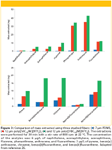
Figure 3
Ionic Liquids in Dispersive Liquid–Liquid Microextraction
Dispersive liquid–liquid microextraction (DLLME) is a rapidly maturing solvent extraction technique for sample preparation. Several features that make this approach attractive include its ease of operation, high throughput, and the capability to achieve high analyte enrichment factors. Introduced by Rezaee and coworkers in 2006, DLLME is a technique that preconcentrates analytes from an aqueous phase to an extraction phase in the presence of a disperser solvent (40). Figure 4 illustrates the basic operating procedures of DLLME. During extraction, a hydrophobic extraction solvent, typically dissolved in a disperser solvent, is injected into an aqueous sample solution. As noted earlier, the disperser solvent is an organic modifier, typically acetone or methanol, that is miscible in both the sample matrix and the extraction phase. This solvent facilitates the formation of extraction solvent microdroplets in the aqueous sample solution. Because of the large surface area of the microdroplets, analytes are quickly extracted, often with high extraction efficiency. The extraction solvent is recovered by centrifugation and separated from the aqueous matrix. The extraction phase is then injected to a chromatographic system for analysis.
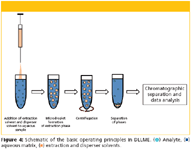
Figure 4
Zhou and coworkers first applied ILs as extraction phases in DLLME (41). The 1-hexyl-3-methylimidazolium hexafluorophosphate ([C6MIM][PF6]) IL was used to extract pyrethroid pesticides from water. Unlike traditional DLLME, the solubility of the IL was manipulated in the aqueous sample by increasing the temperature of the system. After dissolution of the IL in the aqueous phase, the temperature was decreased to allow for the formation of a turbid solution followed by analysis of the extraction phase. Baghdadi and Shemirani (42) expanded the application of IL-based DLLME for the determination of metal ions using [C6MIM][PF6] and [C6MIM][NTf2] ILs as extraction phases. Triton X-114 (Dow Chemical Company) was added to the extraction phase as an antisticking agent to minimize the amount of IL residue remaining on the wall of the sample tube after centrifugation. As a result, the overall absorbance of select metal ions increased and IL carryover from the sample tubes was minimized. Ultrasound-assisted IL-based DLLME was used to minimize the use of high temperatures during extraction. Using this technique, dispersion and homogenization of the IL was achieved within 5 min and excellent enrichment of aromatic amines was observed (43). The extraction of analytes from aqueous solutions containing high ionic strength in IL-based DLLME can result in poorer extraction efficiency because the IL may dissolve in the ion-rich aqueous matrix (44). This was circumvented by exploiting the common ion effect. By adding NaPF6 to the aqueous sample matrix containing high NaNO3 or NaCl content, the miscibility of the [C6MIM][PF6] IL was decreased and enhanced extraction efficiency was achieved (44).
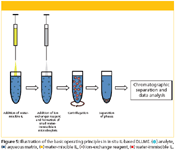
Figure 5
In situ IL-based DLLME was developed by our group to increase the extraction efficiency of analytes and also simplify the extraction steps of traditional IL-based DLLME (45). Figure 5 illustrates the procedure for in situ IL-based DLLME. The water-miscible 1-butyl-3-methylimidazolium chloride ([C4MIM][Cl]) IL was fully dissolved in an aqueous sample solution. An ion-exchange reagent, namely LiNTf2, was added to exchange the [Cl]- anion to [NTf2]-, which immediately resulted in the formation of a turbid solution of the water-immiscible [C4MIM][NTf2] IL. After centrifugation, the [C4MIM][NTf2] IL phase was subjected to HPLC analysis. This approach provided significant advantages over IL-based DLLME and traditional DLLME as it does not require the manipulation of temperature (heating or cooling) and also avoids the use of organic solvents and the need for a disperser solvent. Additionally, because the original extraction phase is dissolved completely in water before the formation of a turbid solution, the microdroplets formed using this method are often smaller, which produced higher enrichment factors for aromatic compounds (45). Figure 6 compares the enrichment factors of aromatic analytes by in situ IL-based DLLME and IL-based DLLME using two different disperser solvents. The former method provided the highest enrichment factors for all analytes (45). The selectivity of ILs for the extraction of emerging contaminants was explored using IL-based DLLME, and the results were compared to in situ IL-based DLLME (46). It was observed that the 1-(6-amino-hexyl)-1-methylpyrrolidinium tris(pentafluoroethyl)trifluorophosphate ([HNH2MPL][FAP]) IL exhibited high selectivity for tertiary amines, and higher enrichment factors were obtained for polar acidic analytes using the [C4MIM][NTf2] IL (46). A glucaminium-based IL was applied as a selective extraction solvent in the in situ IL-based DLLME of boron species in water (47). The preconcentration of boron species into the IL phase was made possible by taking advantage of the selective cis diol functionality within the carbohydrate moiety of the cation (47). Further studies revealed that the glucaminium-based IL can be recovered and reused after the in situ metathesis reaction and extraction by adding 0.1 M hydrochloric acid to the IL phase to displace the complexed boron species (48). Very recently, our group expanded the application of in situ IL-based DLLME to biological samples, namely the extraction of DNA from an aqueous sample solution (16). In an effort to increase selectivity and extraction efficiency, ILs were functionalized with hydroxyl groups as well as aliphatic akyl chains. It was observed that the 1-(1,2-dihydroxypropyl)-3-hexadecylimidazolium bromide ([C16POHIM][Br]) IL exhibited high extraction efficiency for DNA presumably as a result of hydrogen-bonding capabilities and dispersive-type interactions. Data from 31P nuclear magnetic resonance (NMR) spectroscopy suggests that the extraction of DNA is also strongly affected by electrostatic and p-p interactions with the IL (16).
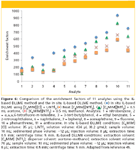
Figure 6
Current Challenges and Future Directions
Because of their tunable structures, ILs and PILs can be readily engineered to exhibit desirable physicochemical properties, providing them distinct advantages over traditional organic solvents for applications in sample preparation. Functionalized ILs and PILs have expanded the applicability of SPME toward more diverse classes of analytes while providing the high selectivity and sensitivity needed for trace-level analyses. Novel fiber modification techniques and sorbent loading and immobilization methods have improved the overall stability of IL- and PIL-based SPME sorbent coatings, allowing for direct-immersion SPME in complex water samples. Analogous to IL- and PIL-based SPME, the use of ILs in DLLME has also been gaining momentum. As a result of the high enrichment factors achieved using functionalized ILs, IL-based DLLME and in situ IL-based DLLME have provided alternative pathways for the preconcentration and analysis of various analytes, including biological samples.
As interests within the field of sample preparation are expanding toward the analysis of biological, environmental, and pharmaceutical samples, concerns over biofouling and reduction in sensitivity can arise in both SPME and DLLME. Thus, it is imperative to develop novel ILs and PILs that can both exhibit high analyte selectivity and resist the potentially damaging components of the sample matrix. Further investigations in sorbent loading methods, coating-to-support immobilization, and using sorbent-protective membranes are possible means to improve matrix resistance of IL- and PIL-based SPME sorbent coatings. Varying extraction and agitation conditions while exploring the use of various functionalized ILs may reduce matrix interference in IL-based DLLME.
For ILs and PILs to be more widely adopted in the analytical chemistry community, their toxicity and environmental effects need to be further investigated. An existing criticism sometimes heard regarding the use of ILs and PILs in sample preparation is their high cost of production compared to many organic solvents. However, because the amount of IL or PIL required is often significantly smaller as a result of their designed high selectivity, the total cost of production can be the same or lower than when using other solvents. The synthesis of highly pure ILs can be challenging and may require purification to minimize the presence of low-level by-products and impurities. Signal interference can be a problem in sample preparation and analysis because some of these impurities may contribute to background UV–vis absorption or fluorescence emission. To ensure high IL purity, analytical laboratories can synthesize ILs in smaller scales while also taking advantage of chromatographic purification techniques. Although careful consideration is needed when synthesizing ILs in bulk, it may be necessary to explore alternative synthetic routes that can provide high yields with minimal purification steps. Given the enormous flexibility offered by ILs and PILs in sample preparation, their use will continue to grow tremendously and it is anticipated that they will soon replace organic solvents in niche applications.
References
(1) A. J. Carmichael and K. R. Seddon, J. Phys. Org. Chem. 13, 591–595 (2000).
(2) Z. Tan, J. Liu, and L. Pang, TrAC, Trends Anal. Chem. 39, 218–227 (2012).
(3) R. Liu, J. Liu, Y. Yin, X. Hu, and G. Jiang, Anal. Bioanal. Chem. 393, 871–883 (2009).
(4) L. Vidal, M.L. Riekkola, and A. Canals, Anal. Chim. Acta 715, 19–41 (2012).
(5) T.D. Ho, A.J. Canestraro, and J.L. Anderson, Anal. Chim. Acta 695, 18–43 (2011).
(6) Q. Zhao and J.L. Anderson, Anal. Bioanal. Chem, 400, 1613–1618 (2011).
(7) N. Fontanals, F. Borrull, and R.M. Marcé, TrAC, Trends Anal. Chem. 41, 15–26 (2012).
(8) H.L. Ngo, K. LeCompte, L. Hargens, and A.B. McEwen, Thermochim. Acta 357, 97–102 (2000).
(9) S.T. Handy, Curr. Org. Chem. 9, 959–988 (2005).
(10) W.H. Awad, J.W. Gilman, M. Nyden, R.H. Harris, T.E. Sutto, J. Callahan, P.C. Trulove, H.C. DeLong, and D.M. Fox, Thermochim. Acta 409, 3–11 (2004).
(11) J.G. Huddleston, A.E. Visser, W.M. Reichert, H.D. Willauer, G.A. Broker, and R.D. Rogers, Green Chem. 3, 156–164 (2001).
(12) F. Endres and S.Z. El Abedin, Phys. Chem. Chem. Phys. 8, 2101–2116 (2006).
(13) R. Hagiwara and Y. Ito, J. Fluorine Chem. 105, 221–227 (2000).
(14) D. Rooney, J. Jacquemin, and R. Gardas, Top. Curr. Chem. 290, 185–212 (2010).
(15) P. Bonhote, A.P. Dias, N. Papageorgiou, K. Kalyanasundaram, and M. Grätzel, Inorg. Chem. 35, 1168–1178 (1996).
(16) T. Li, M.D. Joshi, D.R. Ronning, and J.L. Anderson, J. Chromatogr. A 1272, 8–14 (2013).
(17) T.D. Ho, M.D. Joshi, M.A. Silver, and J.L. Anderson, J. Chromatogr. A 1240, 29–44 (2012).
(18) C.L. Arthur, L.M. Killam, S. Motlagh, M. Lim, D.W. Potter, and J. Pawliszyn, Environ. Sci. Technol. 26, 979–983 (1992).
(19) H. Lord and J. Pawliszyn, J. Chromatogr. A 885, 153–193 (2000).
(20) H. Prosen and L. Zupancic-Kralj, TrAC, Trends Anal. Chem. 18, 272–282 (1999).
(21) J. Liu, N. Li, G. Jiang, J. Liu, J.A. Jonsson, and M. Wen, J. Chromatogr. A 1066, 27–32 (2005).
(22) Y.N. Hsieh, P.C. Huang, I. Sun, T.J. Whang, C.Y. Hsu, H.H. Huang, and C.H. Kuei, Anal. Chim. Acta 557, 321–328 (2006).
(23) K.P. Huang, G.R. Wang, B.Y. Huang, and C.Y. Liu, Anal. Chim. Acta 645, 42–47 (2009).
(24) R. Amini, A. Rouhollahi, M. Adibi, and A. Mehdinia, J. Chromatogr. A 1218, 130–136 (2011).
(25) F. Zhao, Y. Meng, and J.L. Anderson, J. Chromatogr. A 1208, 1–9 (2008).
(26) Y. Meng and J.L. Anderson, J. Chromatogr. A 1217, 6143–6152 (2010).
(27) J. Lopez-Darias, V. Pino, Y. Meng, J.L. Anderson, and A. M. Afonso, J. Chromatogr. A 1217, 7189–7197 (2010).
(28) Y. Meng, V. Pino, and J.L. Anderson, Anal. Chim. Acta 687, 141–149 (2011).
(29) C. M. Graham, Y. Meng, T. Ho, and J.L. Anderson, J. Sep. Sci. 34, 340–346 (2011).
(30) J. Feng, M. Sun, X. Wang, X. Liu, and S. Jiang, J. Chromatogr. A 1245, 32–38 (2012).
(31) J. López-Darias, J.L. Anderson, V. Pino, and A.M. Afonso, Anal. Bioanal. Chem. 401, 2965–2976 (2011).
(32) Q. Zhao, J.C. Wajert, and J.L. Anderson, Anal. Chem. 82, 707-713 (2010).
(33) Q. Zhao and J. L. Anderson, J. Chromatogr. A 1217, 4517–4522 (2010).
(34) F. Zhao, M. Wang, Y. Ma, and B. Zeng, J. Chromatogr. A 1218, 387–391 (2011).
(35) Z. Gao, W. Li, B. Liu, F. Liang, H. He, S. Yang, and C. Sun, J. Chromatogr. A 1218, 6285–6291 (2011).
(36) M. Liu, X. Zhou, Y. Chen, H. Liu, X. Feng, G. Qiu, F. Liu, and Z. Zeng, Anal. Chim. Acta 683, 96–106 (2010).
(37) X. Zhou, X. Shao, J.-j. Shu, M.-m. Liu, H.-l. Liu, X.-h. Feng, and F. Liu, Talanta 89, 129–135 (2012).
(38) X. Zhou, P. Xie, J. Wang, B. Zhang, M. Liu, H. Liu, and X. Feng, J. Chromatogr. A 1218, 3571–3580 (2011).
(39) T. D. Ho, H. Yu, W.T.S. Cole, and J.L. Anderson, Anal. Chem. 84, 9520–9528 (2012).
(40) M. Rezaee, Y. Assadi, M.R. Milani Hosseini, E. Aghaee, F. Ahmadi, and S. Berijani, J. Chromatogr. A 1116, 1–9 (2006).
(41) Q. Zhou, H. Bai, G. Xie, and J. Xiao, J. Chromatogr. A 1177, 43–49 (2008).
(42) M. Baghdadi and F. Shemirani, Anal. Chim. Acta 613, 56-63 (2008).
(43) Q. Zhou, X. Zhang, and J. Xiao, J. Chromatogr. A 1216, 4361–4365 (2009).
(44) S.R. Yousefi and F. Shemirani, Anal. Chim. Acta 669, 25–31 (2010).
(45) C. Yao and J.L. Anderson, Anal. Bioanal. Chem. 395, 1491–1502 (2009).
(46) C. Yao, T. Li, P. Twu, W.R. Pitner, and J.L. Anderson, J. Chromatogr. A 1218, 1556–1566 (2011).
(47) M.D. Joshi, G. Chalumot, Y. Kim, and J.L. Anderson, Chem. Commun. 48, 1410–1412 (2012).
(48) M.D. Joshi, D.J. Steyer, and J.L. Anderson, Anal. Chim. Acta 740, 66–73 (2012).
This month's guest authors:
Tien D. Ho received his BS degree in science from Aquinas College (Michigan) in 2009. He currently attends the University of Toledo as a PhD student in Dr. Jared L. Anderson's group. His research involves examining the selectivity of various functionalized polymeric ionic liquid–based SPME sorbent coatings.

Tien D. Ho
Honglian Yu graduated from China Agricultural University and received a B.S. degree in chemistry in 2010. Currently, she is working as a PhD student in Dr. Jared L. Anderson's group. Her research involves the analysis of water by using polymeric ionic liquid-hydrogels as sorbent coatings in SPME.

Honglian Yu
William T.S. Cole is a junior undergraduate student at the University of Toledo pursuing a double major in Chemistry and Applied Mathematics with a minor in Physics. Will currently works in Dr. Anderson's research group focusing on the development of novel SPME coatings using PILs.

William T.S. Cole
Jared L. Anderson obtained his B.S. degree in chemistry at South Dakota State University in 2000 and his PhD in analytical chemistry at Iowa State University in 2005. He is a Professor of Chemistry at The University of Toledo and a member of LCGC's editorial advisory board. His research interests include the synthesis of new classes of ionic liquids and materials derived from polymeric ionic liquids, the use of ionic liquids as catalytic solvents, and the use of ionic liquids in all aspects of separation science including analytical extractions, purification, and chromatography. Direct correspondence to: Jared.Anderson@UToledo.edu

Jared L. Anderson
The editor of Column Watch:
Ronald E. Majors "Sample Prep Perspectives" Editor Ronald E. Majors is a Senior Scientist in the Columns and Supplies Division at Agilent Technologies in Wilmington, Delaware, and is a member of LCGC's editorial advisory board. Direct correspondence about this column via e-mail to lcgcedit@lcgcmag.com.

Ronald E. Majors
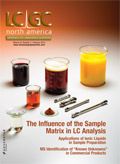
Thermodynamic Insights into Organic Solvent Extraction for Chemical Analysis of Medical Devices
April 16th 2025A new study, published by a researcher from Chemical Characterization Solutions in Minnesota, explored a new approach for sample preparation for the chemical characterization of medical devices.
Study Explores Thin-Film Extraction of Biogenic Amines via HPLC-MS/MS
March 27th 2025Scientists from Tabriz University and the University of Tabriz explored cellulose acetate-UiO-66-COOH as an affordable coating sorbent for thin film extraction of biogenic amines from cheese and alcohol-free beverages using HPLC-MS/MS.
Multi-Step Preparative LC–MS Workflow for Peptide Purification
March 21st 2025This article introduces a multi-step preparative purification workflow for synthetic peptides using liquid chromatography–mass spectrometry (LC–MS). The process involves optimizing separation conditions, scaling-up, fractionating, and confirming purity and recovery, using a single LC–MS system. High purity and recovery rates for synthetic peptides such as parathormone (PTH) are achieved. The method allows efficient purification and accurate confirmation of peptide synthesis and is suitable for handling complex preparative purification tasks.

.png&w=3840&q=75)

.png&w=3840&q=75)



.png&w=3840&q=75)



.png&w=3840&q=75)





